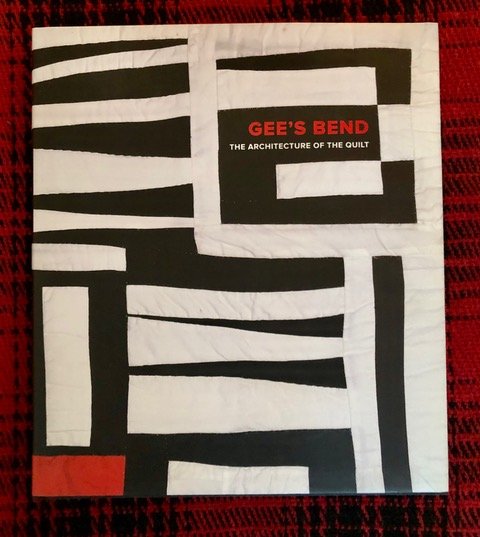The Quilts of Gee’s Bend
Observed over time, a river can be seen as having a life of its own. After flowing in an historically described channel, the focus of its waters erodes, changes course, creates oxbows and islands of isolation, intermittently dries up and periodically floods its banks. River towns and bottomlands are enriched some years and devastated others. Rivers define both the places and the people whose lot it is to live out their lives nearby. Generations of quilters in Gee’s Bend, Alabama, will tell you that.
For three decades, Kit and I hung quilts as works of art and slept under others over the cold winter months that we lived in Missouri. In addition to traditional locally made quilts, we came to admire the artistry of classic Amish quilts—those conceived and stitched by women of Lancaster, PA from 1870 to 1950. Their geometric patterns, at once homemade creations of practicality and simplicity, reflected the essence of Amish principles. For their bold colors and purity of design, they have been recognized as true works of American art.
Then, I discovered the artistry of the quilters of Gee’s Bend in a 2007 issue of Smithsonian magazine. In his article, “Fabric of our Lives,” New York Times art critic Michael Kimmelman described the “eye-poppingly gorgeous Gee’s Bend” quilts as “some of the most miraculous works of modern art America has produced. Imagine Matisse and Klee arising not from rarefied Europe, but from the caramel soil of the rural South.”
These novel quilters are African American descendants of former slaves from Gee’s Bend—a community established in 1816 by Joseph Gee as a cotton plantation on an almost completely isolated, island-like bend in the Alabama River. Following the Civil War came years of hard-scrabble life as tenant farmers. Meager government support dissipated, and cotton farming continued to decline in the 1920s and 30s.
In this period, Gee’s Bend residents faced starvation and grew increasingly cut off from social and economic developments of the rest of the country. Ultimately, the government purchased the land in Gee’s Bend from white owners, sold it back to the African American farmers at a dollar and acre, and built new homes to replace existing log cabins. Over time, the town’s struggles and the story of its survival were passed on in songs sung by the women of Gee’s Bend and the recycled fabrics that found new life in their quilts.
In the 1960s, an Episcopalian minister sold some of the Gee’s Bend quilts at auction in New York to raise money for the needy quilters. This led to contracts for standardized quilts from Saks Fifth Avenue and Bloomingdales and in the 1970s contracts with Sears, Roebuck revived the community’s economy until the mid-1980s. The quilters continued to make quilts but now solely for their own homes and the community. When a family of collectors rediscovered their work in the 1990s, the history and story of the Gee’s Bend quilters came to the attention of the world. In 2005, Gee’s Bend quilts were featured on a USPS 39-cent stamp commerating their place as American treasures.
In 2008, Kit and I visited our friends Judith McCandless and Grady Clay in Louisville, KY when the Gee’s Bend quilt exhibition was at the Speed Art Museum. The exhibition “Gee’s Bend: The Architecture of the Quilt” featured 70 quilts created by 42 women spanning four generations. Early quilts were made of blocks of stripes of worn denim, cotton, and corduroy work clothes as their function was keeping families warm in the winter months and comfortable the rest of the year. From 1945 to the present, bold combinations of broad, abstract patterning and vibrant colors found their way into quilts now recognized as masterpieces of contemporary American and modern art, not just functional decorations.
Our L.A. friends Pat and Gary have recently seen examples of Gee’s Bend quilts at the Huntington Art Museum. Through them, I’ve learned about an installation of unique prints by members of Gee’s Bend Collective from Alabama made during an artistic residency at Paulson Fontaine Press in Berkeley, CA. Through an inventive process, a quilt is translated to a printed surface—a new medium to explore and share the quiltmakers’ creativity. “Gee’s Bend: Shared Legacy” is on exhibit at the Huntington’s Virginia Steele Scott Galleries of American Art through Sept. 4, 2023. Another stunning quilt exhibition my friends have now visited twice is “Fabric of a Nation: American Quilt Stories”—currently at the Skirball Cultural Center in Los Angeles through March 23, 2023.
https://huntington.org/exhibition/gees-bend-shared-legacy
https://www.skirball.org/exhibitions/fabric-nation-american-quilt-stories
Members of the Gee’s Bend Collective were featured in the 2022 Amazon Fashion Gift Guide as one of their customers’ “most-loved small businesses.” Once cut off from the world by flooding and erosion on the Alabama River, the river town of Gee’s Bend—home to one of the most important African American quilt-making traditions in the United States—continues today to share its legacy of textiles and techniques passed down through the generations.





